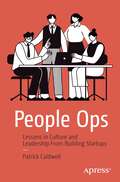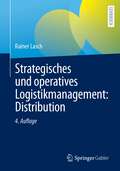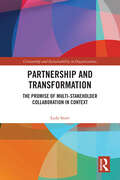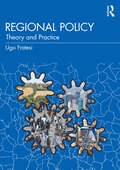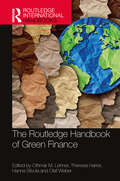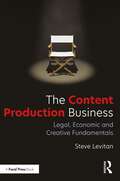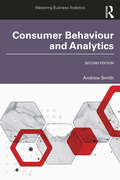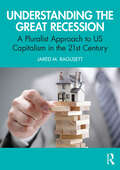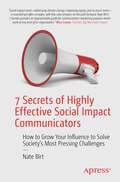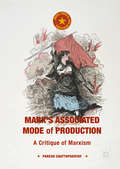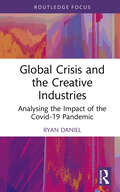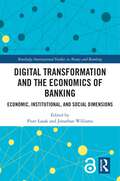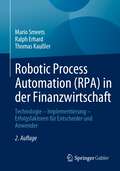- Table View
- List View
People Ops: Lessons in Culture and Leadership From Building Startups
by Patrick CaldwellLearn how to deal with difficult employee demands, what candidates actually think about recruitment processes, how to navigate layoffs, address the gender pay gap, and protect your time and wellbeing. People Ops is a collection of candid lessons, stories, and principles in leadership, people, and culture from startup environments. It reveals the hard truths and sometimes uncomfortable realities that we all know exist but struggle to articulate.For decades, business and HR leaders have struggled to navigate the complexities of managing people and teams within startups and scaling companies, instead relying on the broad rhetoric of management theory to tackle these challenges or leaning on their networks of leaders who have encountered these challenges before. In parallel, the HR industry has been undergoing a transformation with the growth of People Operations. It’s a distinct field in HR that relentlessly focuses on engagement, culture, automation and putting people at the heart of all business operations. At the intersection of startups and people operations is an increasingly ambiguous business challenge for how startups can apply leading people practices to drive their growth, rather than in spite of their growth.People Ops is a tactical companion for business and People Operations leaders designed to support them in their roles, spark inspiration and challenge conventional thinking. It supplements author Patrick Caldwell's own experience across multiple startups with stories and examples from his network of investors, CEOs, Founders and C-Level HR executives.What You'll LearnLessons from a path walked building People Operations in a startup environmentUncomfortable truths around the complexities of managing people The key components of a People Operations strategy within a small businessWho This Book is ForThose in small-medium sized businesses, especially startups, where the reader is in a position of responsibility for people and culture. They’ll likely hold business leadership positions such as Founder, CEO, COO, VP and Director, or they’ll be directly within the HR and People Operations space with titles such as CHRO/CPO, Head, Director, Business Partner or Advisor
Proaktive Marketing- und Vertriebs-Impulse: Content, Automatisierung, KI, Daten & Trends – worauf sich das B2B- und B2C-Business vorbereiten müssen
by Olaf MörkDieses Buch für Marketing- und Vertriebs-Entscheider entwirrt die komplexen Veränderungen, die auf Unternehmen zurollen. Der Autor zeigt, welche technischen und kommunikativen Herausforderungen für B2B- und B2C-Unternehmen anstehen, wie Strategien für die Zukunft aufgestellt und wie sie umgesetzt werden können.Die großen Trends der letzten Jahre stoßen an ihre Wachstumsgrenzen und die Explosion der Angebote im MarTech-Bereich hat vielfach zur Verwirrung geführt. Jetzt klopfen weitere, neue Trends aus der digitalen Welt an (Generative AI, Avatare, Composability, ...).Wie gewinnen Marketingabteilungen in diesem Technologie- und Content-Dschungel die Aufmerksamkeit ihrer Kunden und behalten selber den Überblick? Olaf Mörk analysiert dafür die relevanten Trends. Dieses Buch – mit zahlreichen Praxisbeispielen (z. B. 1.000 % mehr Leads), Abbildungen und Tipps – ist eine wertvolle Inspirationsquelle für alle, die sich für die Herausforderungen in Marketing und Vertrieb der kommenden Jahre rüsten wollen.Aus dem InhaltDas geänderte Informationsverhalten von Gen Y und Gen Z fordern Marketing und Vertrieb herausNeueste Trends verstehen und nutzen: Virtuelle-Influencer, ChatGPT, KI-Agents, Internet of Think (IoTK), Avatare, Web3, Composability, Cognitive Computing, Super-Apps und Social MediaSituatives-Content-Marketing (SCM), Social Selling und New Sales LeadershipGemeinsam zum Erfolg: das Erfolgstrio Marketing + Vertrieb + CDO Marketing Automation, Big Data und Data Governance – Chancen und Herausforderungen LinkedIn als effektives B2B-Social-Media-Netzwerk: Praktische Tipps und TricksMit einem Geleitwort René Kühn, Initiator von CMCX/Content-Marketing.Com
Strategisches und operatives Logistikmanagement: Distribution
by Rainer LaschDieses Buch behandelt das Subsystem Distributionslogistik, wobei insbesondere Planungsprobleme, Lösungskonzepte und Strategien im Vordergrund stehen. Die quantitativen Planungsmethoden werden in ihrem Verfahrensablauf algorithmisch beschrieben und an mehr als 70 logistischen Anwendungsbeispielen anschaulich verdeutlicht. Für die Bereiche Transport-, Umlade-, Rundreise-, Touren- und Standortplanung erfolgen eine didaktisch geeignete Modellierung der Probleme sowie die Vermittlung verschiedener Lösungskonzepte. Zusätzlich wird eine anwendungsfreundliche Planungssoftware „Logistik-Toolbox“ zur Verfügung gestellt, in der die in diesem Buch verwendeten Planungsverfahren implementiert sind. Somit können auch praxisrelevante Problemstellungen mit dieser Planungssoftware leicht gelöst werden. In der dritten Auflage wurden insbesondere die Standardsoftwarepakete zur Tourenplanung aktualisiert sowie das Kapitel zur physischen Distribution um Nachhaltigkeitsaspekte erweitert.
Partnership and Transformation: The Promise of Multi-stakeholder Collaboration in Context (Citizenship and Sustainability in Organizations)
by Leda StottOver the last 30 years, partnership has received growing attention across a range of sectors and disciplines. Widely used to describe a relationship in which different actors pool their resources, knowledge and skills to address common problems, partnership is currently presented as central to the achievement of more inclusive and sustainable development. Rejecting "one size fits all" approaches, and mindful of different understandings of the term, Partnership and Transformation: The Promise of Multi-stakeholder Collaboration in Context, which is designed to appeal to both academics and practitioners alike, argues that partnership must be understood in relation to specific contexts and the added value it may offer for individuals, organisations and wider society. It is further suggested that the transformational potential of partnership rests critically upon a move away from purely instrumental considerations of its worth to a deeper appreciation of its intrinsic value as a process based on interpersonal relationships. A stronger balance between pragmatic and reflective dimensions of partnership can, the author claims, enhance opportunities for meaningful deliberation and productive conflict and contribute to the systems change needed for a global citizenship that embraces human well-being and stewardship of the planet.
Regional Policy: Theory and Practice
by Ugo FratesiRegional policy is an essential in any government’s toolkit for promoting socioeconomic prosperity. It comes in many forms and can be used to target the development of weak and stronger regions. This textbook provides comprehensive and systematic coverage of regional policy, dealing with core theories and looking at contemporary challenges in practice, addressing regional policy across the world. Structured in four parts, the book opens with an exploration of regional policy’s characterisation, aims and rationale. The second part is devoted to issues of implementation and the instruments available to policymakers for intervention. The third part addresses regional policy evaluation, as well as statistics and modelling in policymaking. Finally, the book discusses how regional policy is applied in different contexts. Each chapter contains real-life examples of a regional policy topic in action and highlights supplementary topics for advanced readers. With its broad coverage of the subject, Regional Policy: Theory and Practice will prove a valuable resource for advanced students, researchers and practitioners in regional policy, regional economics, economic geography, planning and public policy.
The Routledge Handbook of Green Finance (Routledge International Handbooks)
by Othmar M. Lehner, Theresia Harrer, Hanna Silvola and Olaf WeberGreen finance is heralded in theory and practice as the new panacea – the ideal way to support the green transition of businesses into more sustainable, environmentally responsible forms, by means of incentivized financial investments. This handbook brings together a variety of expert scholars with industry specialists to offer the most authoritative overview of green finance to date, presenting the current situation in the field. It focuses on green finance in a comprehensive way, discussing its characteristics, underlying principles, and mechanisms. The book carefully illuminates the issues surrounding green finance and delineates its boundaries, mapping out and displaying the disparate voices, traditions, and professional communities engaged in green and sustainable finance activities. Specifically, it examines the "environmental" in the environmental, social, and governance (ESG) measurements, while also discussing the interplay between each measurement. It develops a range of analytic approaches to the subject, both appreciative and critical, and synthesizes new theoretical constructs that make better sense of hybrid financial relationships. Furthermore, the handbook illustrates existing best practices and theories, and critically examines the gaps to derive the necessary future research questions. It highlights the essential issues and debates and provides a robust research agenda. As such, it helps to create an effective market for the various green financing instruments through clarification and standardization. This handbook will be the standard reference work for a broad audience, encompassing scholars, researchers, and students but also interested professionals, regulators, and policymakers wishing to orient themselves in a rapidly developing and increasingly topical field.
The Routledge Handbook of Green Finance (Routledge International Handbooks)
by Othmar M. Lehner Theresia Harrer Hanna Silvola Olaf WeberGreen finance is heralded in theory and practice as the new panacea – the ideal way to support the green transition of businesses into more sustainable, environmentally responsible forms, by means of incentivized financial investments. This handbook brings together a variety of expert scholars with industry specialists to offer the most authoritative overview of green finance to date, presenting the current situation in the field. It focuses on green finance in a comprehensive way, discussing its characteristics, underlying principles, and mechanisms. The book carefully illuminates the issues surrounding green finance and delineates its boundaries, mapping out and displaying the disparate voices, traditions, and professional communities engaged in green and sustainable finance activities. Specifically, it examines the "environmental" in the environmental, social, and governance (ESG) measurements, while also discussing the interplay between each measurement. It develops a range of analytic approaches to the subject, both appreciative and critical, and synthesizes new theoretical constructs that make better sense of hybrid financial relationships. Furthermore, the handbook illustrates existing best practices and theories, and critically examines the gaps to derive the necessary future research questions. It highlights the essential issues and debates and provides a robust research agenda. As such, it helps to create an effective market for the various green financing instruments through clarification and standardization. This handbook will be the standard reference work for a broad audience, encompassing scholars, researchers, and students but also interested professionals, regulators, and policymakers wishing to orient themselves in a rapidly developing and increasingly topical field.
The Content Production Business: Legal, Economic and Creative Basics for Producers
by Steve LevitanThis book goes beyond the technical steps in the process of making film, TV, and media material, examining what it means to be an ongoing supplier of content to the marketplace and how to become one. Steve Levitan brings insights and experience from his lifelong career producing in the content industry, where he has also acted as a professional advisor to content makers, distributors and providers, whilst setting up his own production company. Producing as a Business offers strategic, tactical, financial, legal and marketing insights for the successful establishment of content creation enterprises. Readers will gain insight into how to avoid starting from square one with each project, while also learning how to maintain a meaningful level of ownership and build a revenue stream that can sustain a core operation, helping establish them as a “player” in the industry. This text is aimed at the international production industry, with real examples referred to throughout. Film, television, and media production students who are looking to understandthe business of producing, as well as first-time producers who are already familiar with the basics of the production process, will benefit from an examination of the building blocks that form lasting production companies.
The Content Production Business: Legal, Economic and Creative Basics for Producers
by Steve LevitanThis book goes beyond the technical steps in the process of making film, TV, and media material, examining what it means to be an ongoing supplier of content to the marketplace and how to become one. Steve Levitan brings insights and experience from his lifelong career producing in the content industry, where he has also acted as a professional advisor to content makers, distributors and providers, whilst setting up his own production company. Producing as a Business offers strategic, tactical, financial, legal and marketing insights for the successful establishment of content creation enterprises. Readers will gain insight into how to avoid starting from square one with each project, while also learning how to maintain a meaningful level of ownership and build a revenue stream that can sustain a core operation, helping establish them as a “player” in the industry. This text is aimed at the international production industry, with real examples referred to throughout. Film, television, and media production students who are looking to understandthe business of producing, as well as first-time producers who are already familiar with the basics of the production process, will benefit from an examination of the building blocks that form lasting production companies.
Consumer Behaviour and Analytics (Mastering Business Analytics Ser.)
by Andrew SmithThe second edition of Consumer Behaviour and Analytics provides a consumer behaviour textbook for the new marketing reality. In a world of Big Data, machine learning and artificial intelligence, this key text reviews the issues, research and concepts essential for navigating this new terrain. It demonstrates how we can use data-driven insight and merge this with insight from extant research to inform knowledge-driven decision-making. Adopting a practical and managerial lens, while also exploring the rich lineage of academic consumer research, this textbook approaches its subject from a refreshing and original standpoint. It contains numerous accessible examples, scenarios and exhibits, and condenses the disparate array of relevant work into a workable, coherent, synthesized and readable whole. Providing an effective tour of the concepts and ideas most relevant in the age of analytics-driven marketing (from data visualization to semiotics), the book concludes with an adaptive structure to inform managerial decision-making. Consumer Behaviour and Analytics provides a unique distillation from a vast array of social and behavioural research merged with the knowledge potential of digital insight. It offers an effective and efficient summary for undergraduate, postgraduate or executive courses in consumer behaviour and marketing analytics, and also functions as a supplementary text for other marketing modules. Online resources include PowerPoint slides.
Understanding the Great Recession: A Pluralist Approach to US Capitalism in the 21st Century
by Jared M. RagusettThe Great Recession, including the preceding events and the subsequent recovery period, has been the dominant feature of US capitalism in the 21st century. But what can we learn about economic behavior, policies, and relationships by studying this period of marked general decline? Understanding the Great Recession seeks to answer this question by facilitating an advanced theoretical and practical understanding of the Great Recession, using multiple approaches to economic analysis. This textbook uses the Great Recession as a case study for understanding economic concepts, the conduct of policymaking, and competing schools of economic thought. It introduces readers to multiple perspectives on the crisis, including feminist, institutionalist, Marxian, monetarist, neoclassical, post-Keynesian, and stratification economics, amongst others. Divided into four parts, the textbook begins by introducing readers to the headline events of the crisis, and the major differences between neoclassical and heterodox economics. The second part investigates the lead-up to the crisis, beginning with the long-term restructuring of capitalism following the Great Depression, the housing market bubble, and the transmission of the 2008 financial crisis. The third part investigates the policy responses to the crisis, such as financial reform, monetary policy, and fiscal policy. In the final part, economic performance, the shift toward populism, and policy developments during the recovery are all analyzed. Providing the basis for understanding the long-term trajectory of capitalism today, this book is an invaluable resource for students of economics, public policy, and other related fields.
Consumer Behaviour and Analytics (Mastering Business Analytics Ser.)
by Andrew SmithThe second edition of Consumer Behaviour and Analytics provides a consumer behaviour textbook for the new marketing reality. In a world of Big Data, machine learning and artificial intelligence, this key text reviews the issues, research and concepts essential for navigating this new terrain. It demonstrates how we can use data-driven insight and merge this with insight from extant research to inform knowledge-driven decision-making. Adopting a practical and managerial lens, while also exploring the rich lineage of academic consumer research, this textbook approaches its subject from a refreshing and original standpoint. It contains numerous accessible examples, scenarios and exhibits, and condenses the disparate array of relevant work into a workable, coherent, synthesized and readable whole. Providing an effective tour of the concepts and ideas most relevant in the age of analytics-driven marketing (from data visualization to semiotics), the book concludes with an adaptive structure to inform managerial decision-making. Consumer Behaviour and Analytics provides a unique distillation from a vast array of social and behavioural research merged with the knowledge potential of digital insight. It offers an effective and efficient summary for undergraduate, postgraduate or executive courses in consumer behaviour and marketing analytics, and also functions as a supplementary text for other marketing modules. Online resources include PowerPoint slides.
Understanding the Great Recession: A Pluralist Approach to US Capitalism in the 21st Century
by Jared M. RagusettThe Great Recession, including the preceding events and the subsequent recovery period, has been the dominant feature of US capitalism in the 21st century. But what can we learn about economic behavior, policies, and relationships by studying this period of marked general decline? Understanding the Great Recession seeks to answer this question by facilitating an advanced theoretical and practical understanding of the Great Recession, using multiple approaches to economic analysis. This textbook uses the Great Recession as a case study for understanding economic concepts, the conduct of policymaking, and competing schools of economic thought. It introduces readers to multiple perspectives on the crisis, including feminist, institutionalist, Marxian, monetarist, neoclassical, post-Keynesian, and stratification economics, amongst others. Divided into four parts, the textbook begins by introducing readers to the headline events of the crisis, and the major differences between neoclassical and heterodox economics. The second part investigates the lead-up to the crisis, beginning with the long-term restructuring of capitalism following the Great Depression, the housing market bubble, and the transmission of the 2008 financial crisis. The third part investigates the policy responses to the crisis, such as financial reform, monetary policy, and fiscal policy. In the final part, economic performance, the shift toward populism, and policy developments during the recovery are all analyzed. Providing the basis for understanding the long-term trajectory of capitalism today, this book is an invaluable resource for students of economics, public policy, and other related fields.
7 Secrets of Highly Effective Social Impact Communicators: How to Grow Your Influence to Solve Society's Most Pressing Challenges
by Nate BirtSocial impact communication is quickly become a mandatory skill for leaders of modern businesses and nonprofits, at all levels of an organization. Yet using strategy, language and influence to advance game-changing societal breakthroughs isn’t something most people learn in college. This book provides a pathway for empathy, clarity and persuasive communication to advance the social impact work that can help people, their families and society.Too often, workplaces leave these essential capabilities to chance or trust osmosis to do the work. These aren’t skills you can learn in a classroom. They must be learned while actively engaged in the work of social impact leadership. Too many organizations treat social impact communication and programmatic leadership as “just another marketing project.” It’s a tremendous missed opportunity for businesses seeking to add value to society and deepen their client/customer relationships. What’s more, it directly damages other aspects of organizations’ ESG priorities— specifically, their cultivation of a healthy, safe and engaged workplace with team members whose personal values and professional activities are in harmony.Journalist and social impact business executive Nate Birt walks you through the essential mindset shifts and principles needed perform the social impact work that matters and have confidence your headed toward true north. The book includes firsthand insights, how-to strategies and social impact leadership anecdotes, along with insights and tips from dozens of social impact communicators whose perspective will provide you with real-world validation, strategies and encouragement. Each chapter includes a call for personal reflection or action that features a series of question-based prompts to encourage further introspection and journaling. At the end of the book, you'll get access to other resources to continue the conversation and professional development in the area of social impact communication.What You'll LearnUnderstand what makes social impact communication fundamentally different from conventional advertising, journalism or marketingSee why social impact communication requires translational communication capabilities within an organization, across partner stakeholders, and with external audiences, clients and customers.Examine how social impact communication cultivates more engaged leaders and teams by unlocking the power of team members’ individual values and personal purposeWho This Book Is ForSocial-impact executives and their teams in corporate or non-profit settings; non-ESG-focused executives seeking to better understand social impact and associated leadership/management strategies; college or university students seeking to specialize in social impact leadership; think-tank leaders, policymakers or others whose work intersects with social impact disciplines and decision-making.
Lernpraktiken in der Unternehmensberatung: Annäherung aus praxistheoretischer Perspektive (Zukunftsfähige Unternehmensführung in Forschung und Praxis)
by Georg RainerDie Diskrepanz zwischen Bedeutung und Auseinandersetzung mit alltäglichem Lernen im spezifischen Kontext der Unternehmensberatung zum Anlass nehmend, erkundet Georg Rainer Ausprägungsformen und Manifestation von Lernpraktiken sowie auf deren Ausübung einwirkende Faktoren in der Beratungspraxis. Er nutzt Sprachspiel und Konzeption einer praxistheoretisch ausgerichteten Perspektive auf Lernen, um blinde Flecken einer rein individuell-kognitiv ausgerichteten Sichtweise aufzuzeigen. Lernen wird dann als eine primär praktisch-soziale Errungenschaft erkennbar. Empirisch illustriert werden die theoriegeleitet angestellten Überlegungen mit Aussagen von Beratenden unterschiedlicher Beratungsunternehmen. Die Schilderungen aus ihrer Arbeitspraxis lassen auch darauf schließen, dass es nicht immer selbstverständlich ist, in der Beratung Lernpraktiken reproduzieren zu können.
Verwertung kommerzieller Rechte im Sportmarketing: Theorieüberblick und Praxiseinblick
by Andreas BergmannIn diesem Lehrbuch lernen Sie die Grundlagen der Sportvermarktung sowie verschiedene Ausprägungen und Erscheinungsformen der Verwertung gewerblicher Rechte im Sport kennen. Anhand zahlreicher Praxisbeispiele, Statistiken und Studienergebnisse bekommen Sie eine realistische Vorstellung von der Größenordnung, in der sich die Sportvermarktung in Deutschland und weltweit bewegt und welche Anwendungsfälle in diesem Sektor von Relevanz sind. Des Weiteren lernen Sie die theoretische Verortung der Sportvermarktung aus Management- bzw. Marketing- und Kommunikationssicht kennen und können sich mit den rechtlichen Hintergründen vertraut machen. Insgesamt erhalten Sie mit diesem Lehrbuch ein breites Grundlagenwissen zum Thema Sportvermarktung.
Class Struggle: A Political and Philosophical History (Marx, Engels, and Marxisms)
by Domenico LosurdoAvailable for the first time in English, this book examines and reinterprets class struggle within Marx and Engels’ thought. As Losurdo argues, class struggle is often misunderstood as exclusively the struggle of the poor against the rich, of the humble against the powerful. It is an interpretation that is dear to populism, one that supposes a binary logic that closes its eyes to complexity and inclines towards the celebration of poverty as a place of moral excellence. This book, however, shows the theory of class struggle is a general theory of social conflict. Each time, the most adverse social conflicts are intertwined in different ways. A historical situation always emerges with specific and unique characteristics that necessitate serious examination, free of schematic and biased analysis. Only if it breaks away from populism can Marxism develop the ability to interpret and change the world.
Marx's Associated Mode of Production: A Critique of Marxism (Marx, Engels, and Marxisms)
by Paresh ChattopadhyayThis book aims to restore Marx’s original emancipatory idea of socialism, conceived as an association of free individuals centered on working people’s self- emancipation after the demise of capitalism. Marxist scholar Paresh Chattopadhyay argues that, Marx’s (and Engels’s) ideas have been deliberately warped with misinterpretation not only by those who resent these ideas but more consequentially by those who have come to power under the banner of Marx, calling themselves communists. This book challenges those who have inaccurately revised Marx’s ideas justify their own pursuit of political power.
Global Crisis and the Creative Industries: Analysing the Impact of the Covid-19 Pandemic (Routledge Focus on the Global Creative Economy)
by Ryan DanielWorkers in the creative industries are highly motivated, resilient, and innovative and these characteristics have come to the fore during the global health and resultant economic crises enveloping the world. This shortform book analyses transformation in the arts as a result of this era of polycrisis. The author interrogates public policy, legislative developments, and financial support systems to assist the arts sector around the world. Utilising interview responses from various artis and creatives, the book takes the impact of the Covid-19 pandemic on the global creative industries as its central case study. It looks at the historical relationship between art and times of global crises, the policy initiatives implemented around the world in response to Covid-19 to rescue and support creative industries, explores the ways in which audiences, artists, and creatives responded during the first year of the pandemic, and looks towards future opportunities for the creative industries sector. The book also highlights the importance of higher education for the future creative industries workforce. Providing a concise, yet holistic interpretation of the early impact of the pandemic, the book summarises recent developments, and proposes future directions relevant to students and scholars involved in the creative economy.
Global Crisis and the Creative Industries: Analysing the Impact of the Covid-19 Pandemic (Routledge Focus on the Global Creative Economy)
by Ryan DanielWorkers in the creative industries are highly motivated, resilient, and innovative and these characteristics have come to the fore during the global health and resultant economic crises enveloping the world. This shortform book analyses transformation in the arts as a result of this era of polycrisis. The author interrogates public policy, legislative developments, and financial support systems to assist the arts sector around the world. Utilising interview responses from various artis and creatives, the book takes the impact of the Covid-19 pandemic on the global creative industries as its central case study. It looks at the historical relationship between art and times of global crises, the policy initiatives implemented around the world in response to Covid-19 to rescue and support creative industries, explores the ways in which audiences, artists, and creatives responded during the first year of the pandemic, and looks towards future opportunities for the creative industries sector. The book also highlights the importance of higher education for the future creative industries workforce. Providing a concise, yet holistic interpretation of the early impact of the pandemic, the book summarises recent developments, and proposes future directions relevant to students and scholars involved in the creative economy.
Digital Transformation and the Economics of Banking: Economic, Institutional, and Social Dimensions (Routledge International Studies in Money and Banking)
by Piotr 321 Asak Jonathan WilliamsThe book provides deep insight into the processes of digital transformation of banking according to economic, institutional, and social dimensions. Together with the transformation of incumbent banks, the processes result in changes in the scope of existing banking services. Moreover, new entities (FinTech firms) partner with incumbent banks and reshape the banking sector and its financial environment. The far-reaching transformation of banks and the banking sectors is accompanied by some institutional and socioeconomic processes. Regarding institutional processes, the book provides insight into the digitalization of the banking sector from a legal point of view. Traditionally, banking is strongly regulated by norms and rules and this status should be maintained when new entities are entering the sector and/or when new technological solutions contribute to the provision of banking services. Regarding socioeconomic processes, it must be highlighted that digitalization is exerting a powerful impact on societies. One significant example, among others, is the increase in the financial inclusion of disadvantaged groups (especially customers either underserved by the traditional financial sector or unbanked). The socioeconomic aspect, however, has a much greater dimension and its selected aspects are described in this book. The principal audience of the book will be scholars in the fields of banking and finance, but also other related disciplines in the social sciences that are of particular relevance to the banking sector’s digital transformation. This includes legal science, management, and psychology. The book also targets professionals in the financial industry interested in the impact of new financial technologies on banking sectors and bank services, particularly with a main focus on legal and socioeconomic dimensions.
Digital Transformation and the Economics of Banking: Economic, Institutional, and Social Dimensions (Routledge International Studies in Money and Banking)
by Piotr Łasak Jonathan WilliamsThe book provides deep insight into the processes of digital transformation of banking according to economic, institutional, and social dimensions. Together with the transformation of incumbent banks, the processes result in changes in the scope of existing banking services. Moreover, new entities (FinTech firms) partner with incumbent banks and reshape the banking sector and its financial environment. The far-reaching transformation of banks and the banking sectors is accompanied by some institutional and socioeconomic processes. Regarding institutional processes, the book provides insight into the digitalization of the banking sector from a legal point of view. Traditionally, banking is strongly regulated by norms and rules and this status should be maintained when new entities are entering the sector and/or when new technological solutions contribute to the provision of banking services. Regarding socioeconomic processes, it must be highlighted that digitalization is exerting a powerful impact on societies. One significant example, among others, is the increase in the financial inclusion of disadvantaged groups (especially customers either underserved by the traditional financial sector or unbanked). The socioeconomic aspect, however, has a much greater dimension and its selected aspects are described in this book. The principal audience of the book will be scholars in the fields of banking and finance, but also other related disciplines in the social sciences that are of particular relevance to the banking sector’s digital transformation. This includes legal science, management, and psychology. The book also targets professionals in the financial industry interested in the impact of new financial technologies on banking sectors and bank services, particularly with a main focus on legal and socioeconomic dimensions.
Management im Gesundheitswesen: Fallstudien, Aufgaben und Lösungen
by Wolf RogowskiLernen anhand von Fallstudien erfreut sich zunehmender Beliebtheit – auch in der akademischen Ausbildung der Wirtschafts-, Gesundheits- und Pflegewissenschaften, der Medizin oder dem Fach Public Health. Als Ergänzung zu gängigen Lehrbüchern des Managements im Gesundheitswesen wird der Leser in diesem Buch anhand von 28 Fallstudien in zentrale Konzepte der Entscheidungsfindung, des Marketings, der Organisation und des Controllings in Gesundheitsbetrieben eingeführt. Dazu gehören sowohl Klassiker wie Marketing-Mix oder Nutzwertanalyse als auch jüngere Methoden wie Service Blueprinting oder Discrete Event Simulation.Die einheitlich aufgebauten Fallstudien beginnen jeweils mit einem Hintergrundkapitel, in dem ausgewählte Literatur zum vorgestellten Management-Konzept zusammengefasst und Quellen für vertiefende Lektüre empfohlen werden. Anschließend wird praxisnah eine Situation beschrieben, die entlang von Teilaufgaben und mithilfe des jeweils zuvor vorgestellten Konzepts analysiert werden soll. Dieser didaktische Aufbau bietet Studierenden anschauliche Lernsituationen und Lehrenden ein fertig vorbereitetes Seminar, das auf mehrjährigen Lehrerfahrungen beruht. Lehrenden wird die Möglichkeit gegeben auf Musterlösungen zurückzugreifen. Die zweite Auflage wurde durchgesehen, aktualisiert und um zahlreiche neue Fallstudien ergänzt.
Optimierung von Energieversorgungssystemen: Modellierung, Programmierung und Analyse
by Janet NagelWie ein Modell zur Optimierung des Energieversorgungssystems in Deutschland umgesetzt werden kann, zeigt dieses Buch. Im Mittelpunkt steht das Programm Open Energy Modeling Framework (OEMOF) als Software zur Modellierung von Energieversorgungssystemen. Dessen einzelne Elemente sind beispielhaft beschrieben und ein Überblick über den Aufbau des Modells wird gegeben. Die technischen Komponenten von OEMOF sind anhand von mathematischen Berechnungen demonstriert, und sind zusammen mit ausreichend Python-Code präsentiert, um mit der grundlegenden Modellierung zu beginnen. Darüber erhält der Leser ein allgemeines Verständnis für die Umsetzung eines generischen Ansatzes zur Abbildung von Optimierungsproblemen im Energiesektor.Das Buch richtet sich an alle, die sich für Optimierungsmodelle für Energieversorgungssysteme oder für die mathematische Beschreibung der technischen Komponenten solcher Systeme in der praktischen Umsetzung am realen Beispiel von OEMOF interessieren. Thermodynamische Beschreibungen der Verbrennung werden bereitgestellt, so dass sich der Leser auf die Modellierungsaspekte konzentrieren kann. Auch für Forscher und Praktiker ist das Buch nützlich, da es ihr Wissen über die technischen Komponenten von Energieversorgungssystemen, unterstützt durch detaillierte mathematische Berechnungen, erweitert.
Robotic Process Automation (RPA) in der Finanzwirtschaft: Technologie – Implementierung – Erfolgsfaktoren für Entscheider und Anwender
by Mario Smeets Ralph Erhard Thomas KaußlerDieses Buch bringt Ihnen die Robotic Process Automation in der Finanzwirtschaft näher In der Finanzbranche ist das Thema Prozessautomatisierung seit Jahren nicht mehr wegzudenken. Doch wie setzt man solche Veränderungen im Rahmen des Changemanagements erfolgreich und effizient um? Das Buch „Robotic Process Automation in der Finanzwirtschaft“ zeigt es Ihnen. Im Fokus steht der recht junge RPA-Ansatz aus der Intelligent Automation. Dabei imitieren Roboter das menschliche Handeln. Die Eingabe von Befehlen erfolgt direkt über die Oberfläche. So gehören tiefgreifende Softwareveränderungen der Vergangenheit an. Im Zuge dessen klärt dieses Buch u. a. folgende Fragen bezüglich der Robotic Process Automation in der Finanzwirtschaft: • Was ist RPA überhaupt? • Welche Vorteile bringt diese Technologie mit sich? • Welche Erfolgsfaktoren tragen zu einer optimalen RPA-Implementierung bei? • Wie sieht ein mögliches RPA-Kompetenzcenter aus? • Welche Anwendungsbereiche für RPA gibt es? Eine Leseempfehlung für ein breites Zielpublikum Daneben beschäftigen sich die Autoren nicht nur mit dem Ist-Zustand der Robotic Process Automation. Zudem erhalten Sie einen Ausblick auf die zukünftige Entwicklung dieser Software-Lösung. Durch den hohen Praxisbezug ist das Buch speziell für folgende Zielgruppen eine lesenswerte Empfehlung: • Verantwortliche für die Implementierung von Prozessen oder Technologien im IT-Bereich • RPA-Anwender und Personen, die sich dafür interessieren • Erfahrene Experten und Praktiker, die branchenübergreifend mit RPA vertraut sind
